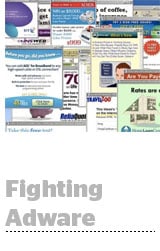 Here’s today’s AdExchanger.com news round-up… Want it by email? Sign-up here.
Here’s today’s AdExchanger.com news round-up… Want it by email? Sign-up here.
Peddle Your ‘Wares
Microsoft will update its Windows PCs in 2016 to purge any insecure adware code in the system. The move is mostly to kill off those man-in-the-middle ad injections. “Our intent is to keep the user in control of their browsing experience, and these methods reduce that control,” Microsoft said in a statement. The most high-profile example of Ads Gone Wild happened in February, when device manufacturer Lenovo decided it would be a spectacular idea to dump Superfish software onto its computers, which injected ads and created lingering security loopholes, even after users removed Superfish from the pond. The ad tech community no longer gets the benefit of the doubt, says Microsoft. “Programs that create advertisements in browsers must only use the browsers’ supported extensibility model for installation, execution, disabling and removal.” Read more on The Guardian.
Seeing The Light
Beacons have passed the adoption tipping point. IKEA, Macy’s, McDonald’s and even Facebook will be deploying tens of thousands of beacons across the country, with hundreds of millions in all expected over the next five years, writes Kate Kaye at Ad Age. But those beacons mean different things for different stakeholders. For marketers, “What’s at stake is finally bringing offline attribution to reality, with big implications for tracking ROI,” says BIA/Kelsey chief analyst Mike Boland. Retailers see a chance to monetize their underdeveloped data. On the other hand, consumers might rather do without the pings, emails, notifications, download prompts and opt-ins. More.
Chop-Chop
A Pew Research Center study on home broadband uptake yielded three key takeaways, some of which have implications for advertisers. First, US home broadband use slightly declined (67% of Americans had it compared to 70% in 2013), partially because of the price of service. Second and simultaneously, more households are going smartphone-only (13% compared to 8% in 2013). Third and most relevant to advertisers: 15% of US adults identify themselves as cord-cutters – meaning they canceled their cable or satellite service. Nine percent of US adults said they never had either. Of that 24% of US adults who don’t have cable or satellite TV, 71% say it’s because cable/satellite is too expensive and 64% say they get their content either via antenna or through online streaming. Read more here.
Social Meh-dia
Twitter is developing a timeline akin to Facebook’s Newsfeed, which displays posts algorithmically and not chronologically. Does that matter to advertisers? For most, organic reach (the numbers of users exposed to an ad) will go down. But Twitter could account for the loss in reach with better engagement numbers. It’s also worth bearing in mind that products released since Jack Dorsey took over, such as Moments, are geared toward the the hundreds of one-time users who don’t return for every one that does. One anonymous agency rep tells Digiday’s Garett Sloane that “At this point, you need to be jaded, because Facebook trained us to be really jaded.” More.
But Wait, There’s More!
- FinTech Brands Are Revolutionizing The Market – Ad Age
- Veritone Media On Programmatic Radio Tools – RadioWorld
- How Food52 Quadrupled Its Instagram Following – WSJ
- AXA Strategic Ventures Adds Four To Portfolio – release
- Foursquare Raising A Down Round For Data Biz – TechCrunch
- Edmunds.com And Krux Launch Auto Data Deal – release
- Gleason On Xaxis Growth Beyond WPP – Beet.tv
- Taboola Signs Deal With Axel Springer’s Die Welt – release
- Facebook Testing Search Within Page Posts – Marketing Land
- Google Pushes App Campaigns Against Facebook – Adweek











